Archive for category exhibitions
No, they’re not real. But they’re spectacular.
Posted by Cai Studio in exhibitions, Falling Back to Earth, installation process on June 18, 2013
Fabrication has begun for Heritage, an installation featuring 99 life-sized animal sculptures, including giraffes, pandas, lions, tigers, and kangaroos, all drinking together from a lake. The installation, surrounded by white sand, is inspired by his visit to Stradbroke Island in 2011.
Heritage will be unveiled for Falling Back to Earth, Cai’s first solo exhibition in Australia staged exclusively at Brisbane’s Queensland Art Gallery | Gallery of Modern Art opening November 23, 2013.
All photos by Cai Canhuang, courtesy Cai Studio.
A few images from Full-Body Scan: Next!
Posted by Cai Studio in exhibitions, Full Body Scan: Next! on June 11, 2013
Cai recently returned from the Venice Biennale, where he unveiled his latest installation Full-Body Scan: Next!
A few images for your enjoyment. All images courtesy Cai Studio.
Full-Body Scan: Next!
Posted by Cai Studio in exhibitions, Full Body Scan: Next! on May 29, 2013
For the 55th Venice Biennale, Cai has been invited to show at White Light / White Heat, the exhibition created in collaboration between curator James Putnam and artisans at Bernego Studio in Venice. Alongside 65 other artists featured, Cai will stage Full-Body Scan: Next!, his first attempt to employ glass as a medium in his work.
Subtly taking root from the fine line between “safety” and “danger.” Cai has asked the glass artisans to fabricate ten wearable suicide bomber’s vests in glass. All parts are made from glass, but the explosives, detonators, wires, and shrapnel in the glass pockets are created from spurious odds and ends posing as the genuine.
A metal-detector gate often seen at security check points will hang a glass suicide bomber’s vest. A slideshow will be projected from behind the vest, showing people of different ethnicity, gender, and attire, each raising their arms with somber facial expressions, as if going through full-body scanners.
At the opening reception on May 31st, models wearing everyday clothes will put on the glass suicide bomber’s vests and nonchalantly wander in Palazzo Cavalli Franchetti, mingling with opening guests. Overhead close-circuit cameras will quietly document the goings-on, quietly suggesting that the danger is everywhere, and not only do we fail to protect ourselves from harm, but we sometimes lack the knowledge of what is the real danger.
White Light / White Heat will be presented in three venues:
Palazzo Cavalli Franchetti, Campo S. Stefano, 2847, Venice;
Berengo Centre for Contemporary Art and Glass, Campiello della Pescheria Murano, Venice;
Scuola Grande Confraternita di San Teodoro, San Marco, 4810, Venice.
We hope to see you there.
Da Vincis do Povo moves onto São Paulo!
Posted by Cai Studio in Cai Guo-Qiang: Da Vincis do Povo Sao Paulo, exhibition openings, exhibitions on April 24, 2013
Cai Guo-Qiang: Da Vincis do Povo moved onto the second leg of its exhibition run in São Paulo. Whereas its previous iteration in Brasilia was nestled deep in the campus greenery of CCBB, this time the flying machines and contraptions took to the streets. Below, a few installation shots, as well as images from opening day.
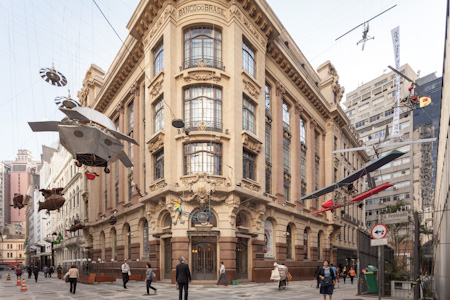
Installation view of Cai Guo-Qiang: Da Vincis do Povo outside the streets of Centro Cultural Banco do Brasil. Photo by Joana França
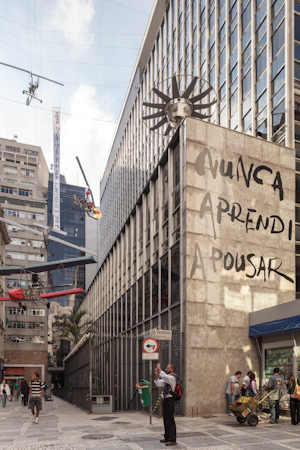
nstallation view of Cai Guo-Qiang: Da Vincis do Povo outside the streets of Centro Cultural Banco do Brasil. Photo by Joana França

Installation view of Carnival Rehearsal, Prédio Histórico dos Correios. Photo by Wen-You Cai, courtesy Cai Studio.
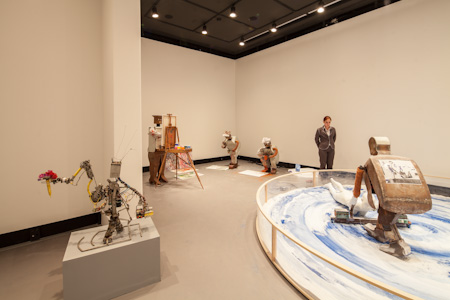
Installation view of Wu Yulu’s Robot Factory, Centro Cultural Banco do Brasil. Photo by Joana França

Installation view of Wu Yulu’s Robot Factory, Centro Cultural Banco do Brasil. Photo by Wen-You Cai, courtesy Cai Studio.
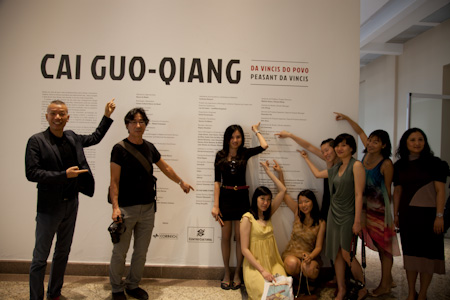
The team made the wall credits! And those are our names! Technical Director Tatsumi Masotoshi looking especially thrilled. Photo courtesy Cai Studio
hey the gang’s in São Paulo!
Posted by Cai Studio in Cai Guo-Qiang: Da Vincis do Povo Sao Paulo, exhibitions on April 11, 2013
After a two-month-long run in Brasilia, Cai Guo-Qiang: Da Vincis do Povo moves onto São Paulo. The exhibition is scheduled to open at both Centro Cultural Banco do Brasil and Museu dos Correios on April 20, before heading to its final stop in Rio de Janeiro in August.
Some images from the installation process thus far for your viewing pleasure.

Installation of Fairytale can only happen between the hours of 11 pm – 5 am, as that is the only time the pedestrian-only walkway in front of CCBB can be closed. At 2 am, we were visited by a local drunk. He offered us a cigarette. We politely declined. Photo by Wen-You Cai, courtesy Cai Studio.
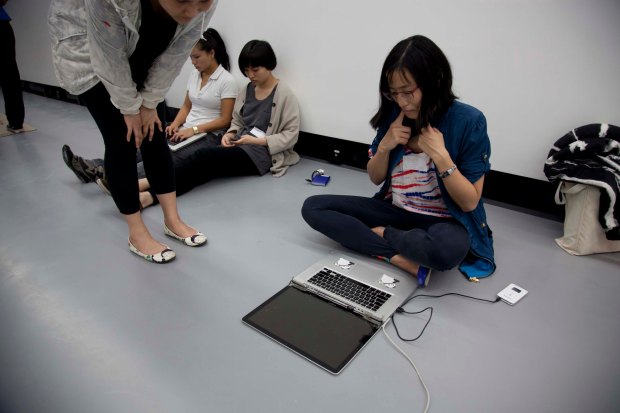
Congratulations, Project Director Chinyan Wong. Your macbook is now a converted windows 8 tablet. Photo by Wen-You Cai, courtesy Cai Studio.
末日是人类的节日
Posted by Cai Studio in 1040M Underground, Explosion Event, Honors, prizes on December 21, 2012
2012年12月21日,是人们创造的一个重大末日。人类总在给自己创造一个个末日,就像艺术家总要给自己的展览找一个开幕时间。但重要不在那一天,而是那天之前和之后人们作了什么?人们总是会跨过那个末日,面向下一个末日而去。
一年多来,我在世界不同文化间往来,以与看不见世界的对话作为作品的深层理念,使不同展览之间相互连接与延伸。“末日”前,我们已跨越了一个个展览的“末日”─开幕式。
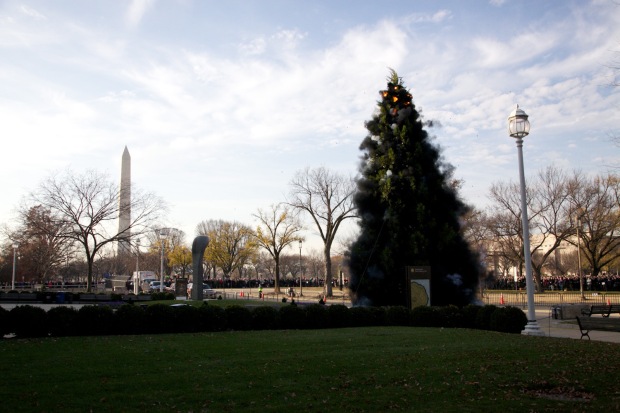
Black Christmas Tree: Explosion Event for Washington, D.C., realized in front of the Freer Gallery of Art, 2012. Photo by Wen-You Cai, courtesy Cai Studio
乌克兰地下1040米
去年秋末,我在乌克兰的一个矿山的城市作了展览,那里同样延续着社会主义文化。为了体验矿工生活,我和他们一起钻进了1000多米深的地下,探索自己与矿工们在社会主义文化深层里的勾连。为防瓦斯爆炸,所有手机,相机都被留下。一个大妈让我们脱光衣服,换上矿工外套、包头包脚、套上长靴、扣上矿工盔、背着供电盒和一个救生氧气筒。矿长说遇难时不动的情况下这氧气筒可支撑一个半小时,我悄悄带去了一张奶奶给我的黄色护身符。向前摸索的途中我们遇到塌方,看着巨大的岩石把比火车铁轨还粗壮的拱形钢梁压弯,矿工们用千斤顶为我们撑起重压… …我曾几次想到应该止步了,可乌克兰人并没停下,他们给过我们许诺,要让我们见识矿工们在地球深处的生活。我们终于爬在了一个只有棺材厚度的岩缝里, 矿长掉转身体说:“到尽头了”。1040米下,我卧在岩板间,暗黑与死寂里突然感受到舒缓与平静的幸福感。后来我邀请了当地一样受社会主义现实主义教育的画家们来写生矿工,并用火药炸出来,成为像革命年代游行队伍肩扛着的领袖肖像,只不过换成了一个个矿工巨大的头像。2个月后, 那里的煤矿发生矿难,20人死亡,17人失踪。在地球的深处,人类还在静悄悄的向尽头走去。
海市蜃楼在多哈
12月,我受卡塔尔公主邀请,来到多哈这个中东迅猛发展的年轻城市举办个展。面对阿拉伯世界深奥的历史和复杂的国际政治环境,我无从着手。我的钥匙是从童年、家乡开始。那里有许许多多阿拉伯人的坟墓,为了这个展览,我去了解了那些碑文都讲什么──“人人都将死去”,“今生的享受尽是虚假”,“死在异乡,既为殉教” 。千百年来,阿拉伯先民们生活在泉州这山清水秀之地,临终依旧怀念那片广袤荒凉的戈壁故乡。我极为感慨,为他们创作了一个返乡的旅程。在美术馆外的戈壁滩上,我开发了白天焰火作了镇魂的黑色仪式,蓝天里炸出一座巨大的黑色金字塔。爆炸瞬间,惊天动地!我还用了当地的石油在空中炸出橘黄的纪念碑,火焰的冲击力瞬时灼热脸面直通心底。来自泉州的穆斯林先民的生命与魂魄,面对的是这片阿拉伯之春的土地上永无终止的战乱纷争!迈进了2012年。
洛杉矶通天的梯子
3月我来到了洛杉矶,在好莱坞标志的山顶旁有一个天文台,去月球的宇航员曾在那受训,训练他们从月球返航途中,一旦仪器失灵,如何用肉眼看宇宙星空,返回地球。我就想从这个天文台点燃一个500多米向宇宙升起的梯子。夕阳下,一个火光红色的梯子伸进云彩,全洛杉矶的人都能看得到。不知这梯子是为了要上去,还是要下来…… 可惜计划没有实现,但展览还是以它为主题,强调了我的作品背后一直有的看不见世界的力量对我的影响。我在当代美术馆内作了3副巨大的火药草图,表现大自然灾害不可抗拒能量之混沌、表现古今人类为走向宇宙,对脱离重力的幻想和各种稚朴的尝试,最后一件33米长4米高取名《童年宇宙船》的画面上,从我奶奶,圣严法师到爱因斯坦,霍金;从El Greco的风景画到倪赞的山水画;从风水故事,气功中医图谱到现代人类对外太空的探索,也包括由90年代以来我实施的外星人计划,炸出少年的我一路成长以来对宇宙和看不见世界的好奇与迷恋。这就是东方的宇宙、我的宇宙:除了宇宙物理学对外太空的探索,地球、自然、生命、还包括风水、中医、气功、神鬼、祖先等等 。
在展厅的天顶我倒挂了大型装置“麦田怪圈”,两百万支草构成的麦田和神秘符号,就像数百年来在田野上反复出现的如恶作剧般的“大地艺术”图案。这些不要著作权的怪圈始终挑衅着人类的智力与理性。
又是一个开幕式,美术馆的外墙上,我将4万只小火箭组成的麦田怪圈在瞬间同时发射,紧接着一个人造的外星人也被导火线勾勒出来了。燃烧痕迹在墙上留下的巨幅壁画,经过三个月展期的风雨,外星人和怪圈慢慢消退,回归空无。
我还为展览画册写了自童年以来与看不见世界关系的99个故事。期待人们透过我炫丽的视觉奇观,开启我作品背后拥有的文化精神通道。
十几年前,有个犹太教著名的拉比告诉我,从古至今世界上很多人死了以后都想葬在耶路撒冷的山谷里。大卫等圣经故事的主人公也葬在那儿。因为世界末日时,上帝会来拯救人间,在那山头上竖起一把梯子,一直伸入云端……
西湖一梦
最美人间四月,我来到西湖中央,搭台作画。 在江南的春,我用瓷色丝绸,满撒平台,便时常久久躺在那铺展的丝绸之上,思量孤山隐居和那西冷眷念,这西湖的妩媚不知灌醉多少文人骚客、奇女佳丽。上西湖第一天我先去了灵隐寺拜拜,虽然创作期间常常雨水细密,浓云遮天,但每当点火之际,总能云开雾散。现在想起来,《春》展就像那丝绸,淡淡,飘飘……
船家族在丹麦
摇篮和母亲的胎盘是人类对船的最初情感,也是人们最早设想的在宇宙中离开重力的摇晃。船让人们往返于不同文化,穿行在现实与非现实,物质与精神和灵性的世界之间。9月在丹麦的展览里我回首从小至今对船的爱恋情结。在展厅内,我请来了福岛磐城我的朋友们,展出了我们共同挖出的来自那片海洋的大船,那是他们送给我的礼物。这些朋友多年来随着这艘船辗转在世界各地,加拿大、纽约、西班牙、台北、尼斯等各地的美术馆。他们来参与大船的组装和开幕仪式,他们是作品的一部分。我们的友情从小小的渔村出发,走向世界,一同华发生白,手脚渐渐不够利落,通过艺术跨越了中日民族之间的风风雨雨。这个开幕式上,我找到一艘仿佛维京海盗的船,船身插满一千八百只小火箭。引爆的刹那,船好像鸟一样张开耀眼翅膀飞跃起来,成为船家族内的新成员。小时候,我常把叠好的纸船放在河上漂流,在岸上跟着跑。当时的我是造船匠,也是船,现在还是这样。
绘画类终身成就奖
10月底到东京去拿世界文化奖,分为绘画、建筑、雕塑、音乐、表演五个类别的终身成就奖,包含诺贝尔奖未能覆盖的文化、艺术领域。授奖理由这样说:“蔡国强的作品延续了传统意义上的绘画,反映在使用画布或纸张,但他是运用了充满力量的爆炸做艺术,并且他的艺术超越平面绘画,让天空、大地成为画布,同时被成千上万人所观赏。”今年是第24届,我是第一个中国国籍的获奖者。在中日关系剑拔弩张的关头,我前往日本领奖, 备受瞩目……
我在日本的记者会上,回顾我曾经在日本8年多的生活,从我离开日本时邻居的依依不舍,说到远亲不如近邻,也说到中日两国若友好相处、相互学习、互补长短,将是世界最好的搭档。也会对人类作出更加伟大的贡献。还说到我们都是东方文明的继承人,应该在东方文化的思想里有智慧来解决当今的难题。这些话当即被日本媒体反复引用。1995年,我受到美国亚洲文化协会(ACC)日美交换计划的邀请,占了日本艺术家的名额去了美国。我把这一次的奖金一千五百万日元,一半捐给ACC培养日本青年艺术家的项目,另一半捐给了福岛的樱花计划。
授奖仪式后,我又去了福岛,那里的地震海啸以及核电站泄露紧紧地揪住了世界的神经。当时我为那里的朋友们在北京拍出了一件作品,本想他们会用在房子再造或失业救急上,未料他们说要种樱花。我想日本已经很多樱花了,但他们说种樱花是因为他们还深爱这块土地,不会离开,也为他们的世代污染了河山表示对后代的悔恨。我和他们一起种樱花,要种十万棵,让这被看不见的放射线污染的土地,从宇宙看过来是一片粉红的海洋。
纽约飓风
从东京回来,受奖就变受灾了,纽约这座傲视全球的科技、经济、文化、政治世界大中心,一受灾,竟然很多天连电都没有了,我们回到农耕时代。一家人点起蜡烛下跳棋,没有电器的夜晚,家里是那么的安静。这个灾难给了我一个停顿,让我思考从08年古根海姆回顾展以来,在不同文化间穿梭的步伐。漫漫长夜可以思考自己的艺术态度、人生态度……没想到2012年这末日的代价对于我是养了12年的两条鱼,在停电的数日里,失去了水的过滤和氧气的输入,熬来了电,却终究死掉了,2012成了它们的末日。
华盛顿的黑色圣诞树
灾难一过,生活恢复了现代的音色。该颁奖颁奖,该领奖的领奖,这回是在华盛顿,美国国务院首次向对国际文化交流作出贡献的艺术家表彰,在国务院的宴会厅,希拉里为我、杰夫.昆斯,奇奇.史密斯等5位艺术家颁发艺术勋章。授奖完,我即来到了史密斯索尼亚美术馆的广场上,那里已经有3000个民众在等着,我立了一棵13米高的松树,树上像圣诞树张灯结彩般的挂了2000个黑烟弹。华盛顿的方尖碑在夕阳的光芒里沉默着,爆炸喷出浓黑的木炭烟云,瞬间生长出一棵水墨般的黑色圣诞树。在“世界末日”来临之前的华盛顿,让经受着世事忐忑的人们一次黑色的幽默和调侃,今年的圣诞节会来的。
末日和作品的爆炸一样,让人感知看不见力量的存在。末日说是人类给自己创造的一个态度,让人们以及人类感到自己的渺小和脆弱,时刻处于偶然,不能掌控中,懂得谦卑和敬畏。每个末日都是一个节日,它成了人类年轮上的一部分,从遥远的时代开始,直到未来。人类面对一个末日,再向着另一个末日走去。我的下一个“末日”是2013年春节前在巴西三个城市巡展的开始。2010年从上海出发的《农民达芬奇》到了巴西,“不知如何降下”在中国社会说的这句话,现在要到巴西去说。几年前当农民为我特地设计的航空母舰建成后,他问我这艘舰的编号是什么,我顺口说“2012”。
Reminder – Cai in conversation at NYPL
Posted by Cai Studio in public talks, Sky Ladder on October 15, 2012
****UPDATE! (as of 2:26 pm EST Monday, October 29)
Due to chaos in nature and forces from unseen worlds (aka, Hurricane Sandy), the event and book signing at New York Public Library on Tuesday, October 30 will be canceled until further notice. Stay tuned for more details and until then, stay dry!
For our friends in New York, just a reminder that Cai will be in conversation with art historian and former Cai Studio Project Director Lesley Ma at the New York Public Library on October 30.
In addition to an in-depth conversation, the free event will feature an audience Q&A and book signing of Cai Guo-Qiang: Ladder to the Sky. The book beautifully documents his recent exhibition at the Museum of Contemporary Art, Los Angeles and includes narrations by the artist himself of his influences, thoughts, and inspirations found throughout his work.
More details here.
And what is a save-the-date without a few images?

Cai Guo-Qiang working with volunteers to create Chaos in Nature, Los Angeles, 2012.
Photo by Joshua White/JWPictures.com, courtesy The Museum of Contemporary Art, Los Angeles

Shadows created by stencil for gunpowder drawing Chaos in Nature, Los Angeles, 2012. Photo by Joshua White/JWPictures.com, courtesy The Museum of Contemporary Art, Los Angeles

Cai Guo-Qiang standing on top of gunpowder drawing Childhood Spaceship in progress, Los Angeles, 2012. Photo by Joshua White/JWPictures.com, courtesy The Museum of Contemporary Art, Los Angeles

Ignition of gunpowder drawing Desire for Zero Gravity, Los Angeles, 2012.
Photo by Joshua White/JWPictures.com, courtesy The Museum of Contemporary Art, Los Angeles

Ignition of gunpowder drawing Desire for Zero Gravity, Los Angeles, 2012.
Photo by Joshua White/JWPictures.com, courtesy The Museum of Contemporary Art, Los Angeles
Sojourn to Jutland
Posted by Cai Studio in A Clan of Boats, Cai Studio team, research, travel on October 11, 2012

Cai Guo-Qiang visiting Bulbjerg, Northern Jutland, 2012
Photo by Tine Harden, courtesy Faurschou Foundation
August 21, Cai and Kelly (Project Manager) landed in Aalborg, three weeks before A Clan of Boats opened on September 6. Aalborg is a city in North Jutland, the peninsula that connects Denmark to continental Europe. Jens Faurschou, co-founder of the Faurschou Foundation (formerly Faurschou Gallery), and Tine Harden, photographer and friend of Jens’s since the two were toddlers (their mothers are life-long best friends), joined Cai and Kelly on the trip to offer a Danish point of view, as Cai explored the land of the north, something still foreign to him with his southeast China upbringing.
The relationship between Cai and Denmark began in 1997, when Louisiana Museum of Modern Art in Humlebæk hosted his first solo exhibition in the Western world, Flying Dragons in Heavens. During the installation period, Cai and his family stayed in the boathouse next to the Museum for over a month. There, he was first exposed to the long and brutal winter of Scandinavia, and developed an interest in the Vikings, their culture and history.

Cai Guo-Qiang standing in front of Svinkløv Badehotel, Nothern Jutland, 2012
Photo by Tine Harden, courtesy Faurschou Foundation
Cai decided to explore North Jutland after reading National Park Thy, a book the foundation sent for Cai’s reference while brainstorming the theme of the exhibition, right after the initial site survey in summer 2011. The lyme grass covered sand dunes under the dramatic clouds photographed in the book intrigued Cai, as they did so many artists before him. The foursome first arrived at Svinkløv, a seaside town 2 hours west of Aalborg, close to Thy. The northwestern coast of Jutland, facing the North Sea, is lined with sandy beaches, where it is so windy, that only plants as close to the ground as the sand-loving lyme grass, and certain subshrubs, could withstand the gust. The athletic Jens led the group up and down the dunes, right next to the Svinkløv Badehotel, a small, simple retreat that dates back to early 20th century. “Many couples come here for a romantic getaway,” Jens explained. “That is why apart from us, you see mostly elderly and young pairs.”

Cai Guo-Qiang taking pictures in front of Svinkløv Badehoel, Northern Jutland, 2012 Photo by Tine Harden, courtesy Faurschou Foundation
The traditional dinner served at the hotel restaurant was very relaxing, hearty, and delicate. Jens and Tine monitored their watches, as they wanted to make sure Cai gets to see the sun setting into the North Sea. And indeed, though very cloudy, the dusk turned the sky a coral pink. Many of the diners put down their silverware and napkins, and joined Cai to capture the last ray of summer sun. Even though it was mid-August, the temperature during the day was at an average of 18C/65F, and as the sun went down, the mercury would drop to around 11C/51F.
The next morning, the quartet set off early to Thy, after a simple, healthy Danish breakfast.

Cai Guo-Qiang looking at warship model at Hanstholme Kirke, Northern Jutland, 2012
Photo by Tine Harden, courtesy Faurschou Foundation
Denmark is largely a plain, and the flatness of the landscape makes it easy to see faraway. Vast fields of various crops unfolded from either side of the highway, with one-story houses straight out of fairy tale illustrations dotting the greenery, and rows of wind turbines steadily turning in the background. Horses in capes, cattle, and sheep, all grazed quietly in the scenery. Before entering the district of Thy, Jens drove along the Limfjord, and made a stop to show Cai a generic ancient church in Hanstholme. The church appeared a minimalist structure with no tower and bearing no cross, common in the area when Christianity first arrived in Scandinavia and later under Lutheran influence.
Next, Jens told Cai about the history of the region as the four got back into the car. “During the Second World War, the Germans were afraid that the Alliance would attack from Denmark, so the German troops were stationed here, along the shore.” He took a turn, and the road was no longer paved with asphalt. “I am pretty sure this was paved by the Germans,” he pointed ahead.

Cai Guo-Qiang at Bulbjerg, Northern Jutland, 2012
Photo by Tine Harden, courtesy Faurschou Foundation

Cai Guo-Qiang standing inside of bunker at Bulbjerg, Northern Jutland, 2012
Photo by Tine Harden, courtesy Faurschou Foundation

Cai Guo-Qiang visiting Vorupør Strand, Northern Jutland, 2012
Photo by Tine Harden, courtesy Faurschou Foundation
The foundation scheduled an appointment with Professor Thomas Højrup, an enthnologist at the University of Copenhagen, but resides in Thorup, very close to Thy. There was some time until the meeting, and Jens suggested another quick stop at Vorupør Strand, a beach covered with empty crab shells, making crunch sounds as people walked over. Fishermen took only the claws of large crabs, leaving the body of the crabs to nature, namely flocks of seagulls that had their eyes set on the feast. Tine asked one of the locals, who loaded baskets of claws onto his truck, and found out that only the claws were consumed as a base of stock. In order for Cai to take photos of the birds flying instead of fighting over dead (partial) crabs, Jens, Tine, and Kelly waved their arms as they jumped, mimicking birds flapping their wings, tricking the seagulls to think large predators were close. Unfortunately there was no photo of this silly action!

Cai Guo-Qiang, project manager, Professor Thomas Højrup and Founder of Faurschou Foundation Jens Faurschou at Thorup Strand, Northern Jutland, 2012
Photo by Tine Harden, courtesy Faurschou Foundation

Cai Guo-Qiang and project manager with Professor Thomas Højrup at Thorup Strand, Northern Jutland, 2012
Photo by Tine Harden, courtesy Faurschou Foundation
Professor Højrup can qualify as a Renaissance man. He led the group to the Thorup Strand, a beach only a stone’s throw from his house, and explained in great detail about the tradition of boat building and seafaring. Thorup is an active fishing harbor, but unlike harbors of the rest of the world, here on the west coast of Jutland, they continue the Viking practice of pulling the hulls ashore instead of docking in the sea. This is why the boats are all built with a flat bottom, and the reason the Vikings could very quickly raid and trade along the coastline of Europe.
At lunch time, Professor Højrup welcomed Cai and co to his house to dine with his family of four. The food was simple, fresh, and delicious, and everyone felt satisfied and grateful for the warmth and hospitality. Then, Professor Højrup drove everyone to his boatbuilding workshop at Slettestrand, where he and a small team teach the local young people the trade of traditional boatbuilding by hand. “In the old days, this would be a craft passed down from fathers to sons,” he said. “We want to continue this tradition, as no two boats are built the same – because no two trees are alike. The art of boatbuilding is not something that can be written down into a formula to follow; it is mostly by experience, by touch. Everyone’s method is slightly different.”
The boats the workshop built are not just for display; many of them were on the beach, just a few steps away from the workshop. The workshop also has a showroom, where they explain to the public where they have found the original vessel or wreck, what period they think the boat was from, and how they either repaired or replicated it. What they do is very similar to that of conservators in a museum, especially those in departments that deal with older artifacts; for instance, piecing together an ancient painting that is now in shreds. The shipbuilders (or “skippers”) at Viking Ship Museum in Roskilde often consult Professor Højrup and his students when they have a new project of replicating an existing, historical boat.
A Clan of Boats
Posted by Cai Studio in A Clan of Boats, video on October 5, 2012
Cai’s latest exhibition A Clan of Boats is well underway, and will be up until December 7, 2012 at the Faurschou Foundation (Copenhagen, Denmark). The show features a set of new gunpowder drawings created with the assistance of local volunteers, the signature installation Reflection–A Gift from Iwaki and Freja: Explosion Event for Faurschou Foundation.
Videographer extraordinaires Mathias Nyholm Schmidt and Simon Weyhe documented the entire process on site–take a look:
You know what we need more of? Feet.
Posted by Cai Studio in A Clan of Boats, exhibitions on August 28, 2012
Cai’s gunpowder drawings are handmade from Japanese hemp paper–crisp, white and incredibly susceptible to smudges. The booties worn by staff members and volunteers (Cai himself likes to up the ante by wearing slippers from the local hotel) are to help prevent unintentional footprints.
A little ditty, taken by photographer Wen-You Cai in Copenhagen, Denmark.
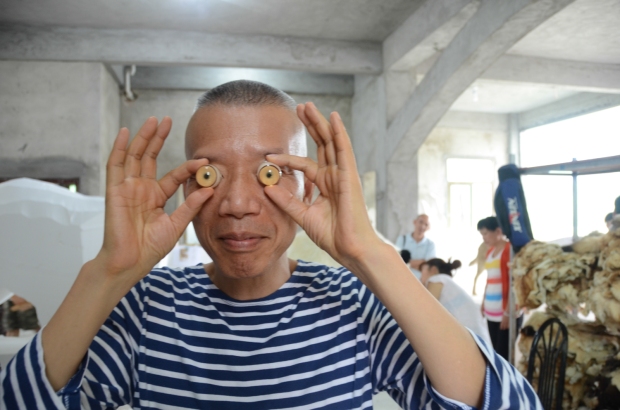


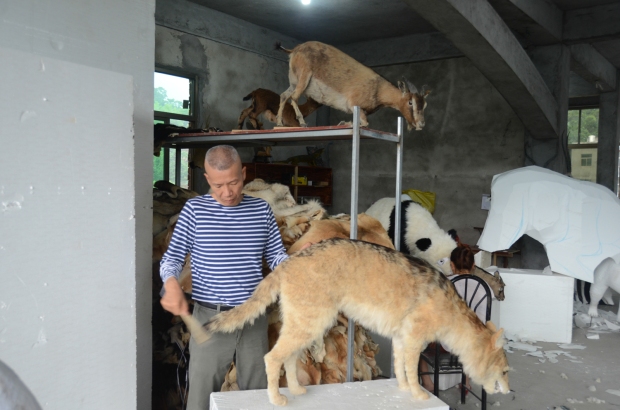

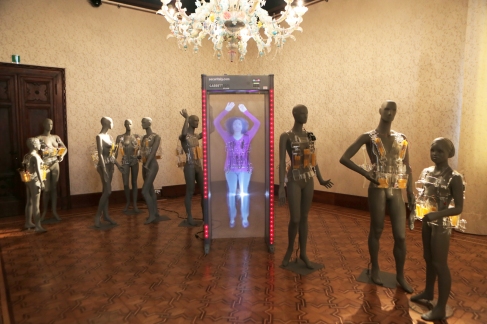


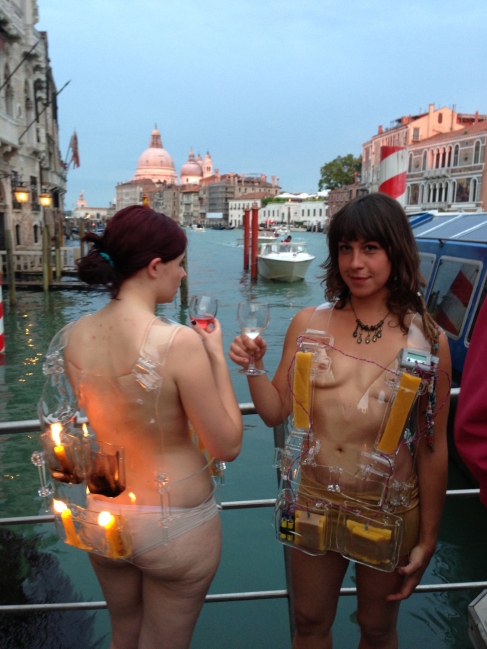

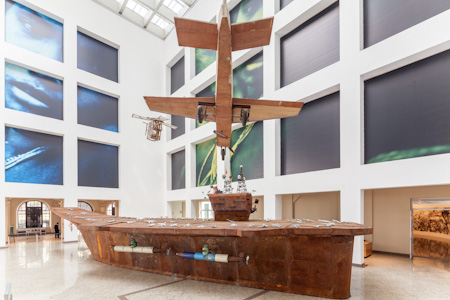



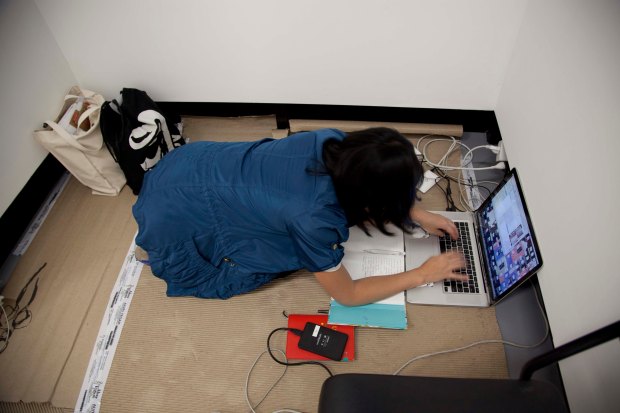



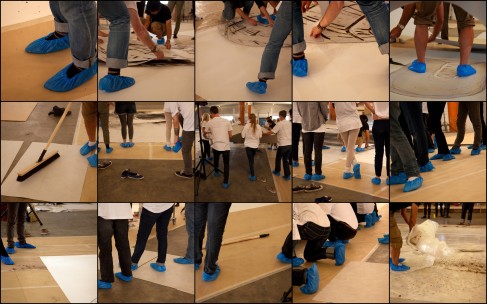
You must be logged in to post a comment.